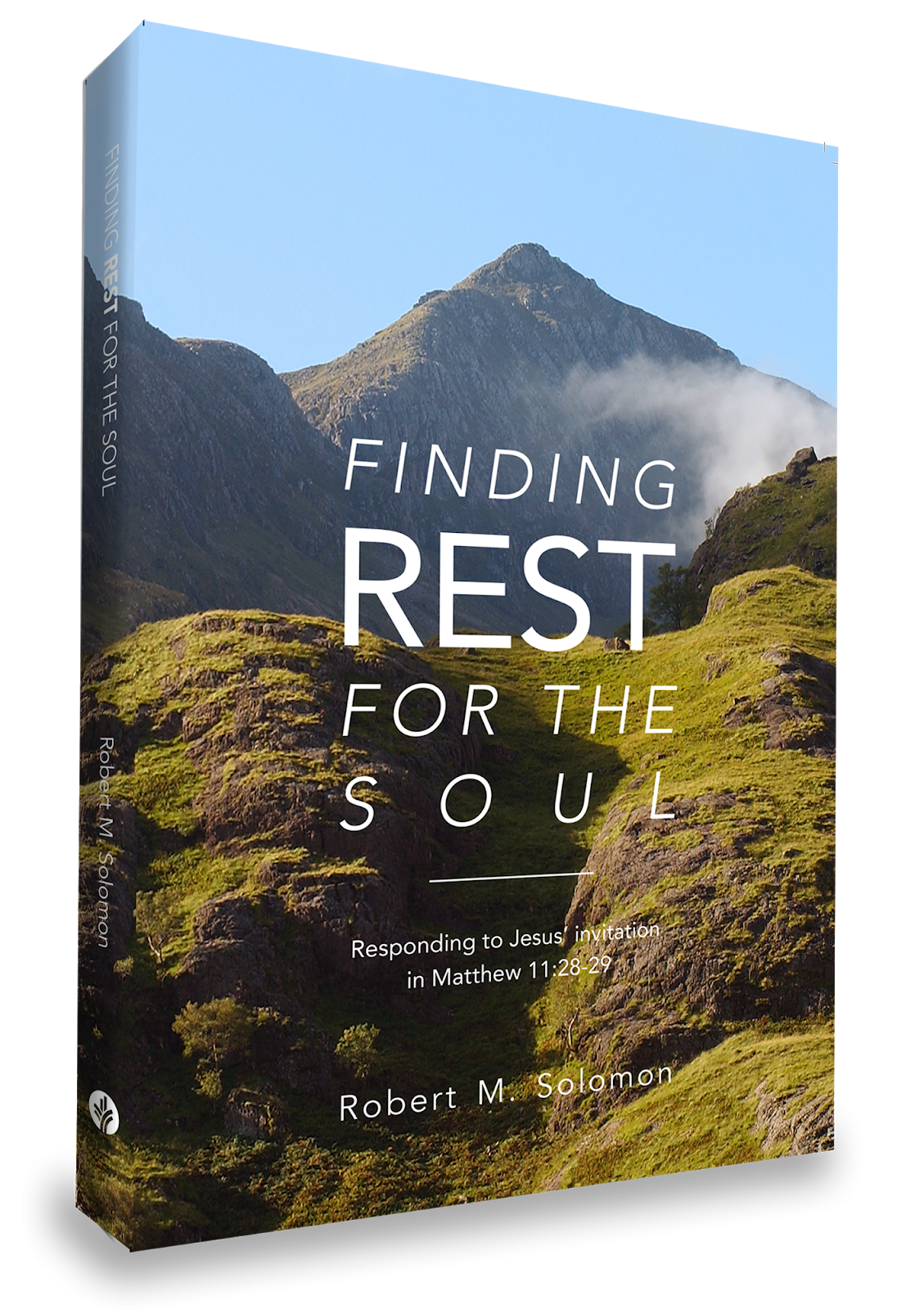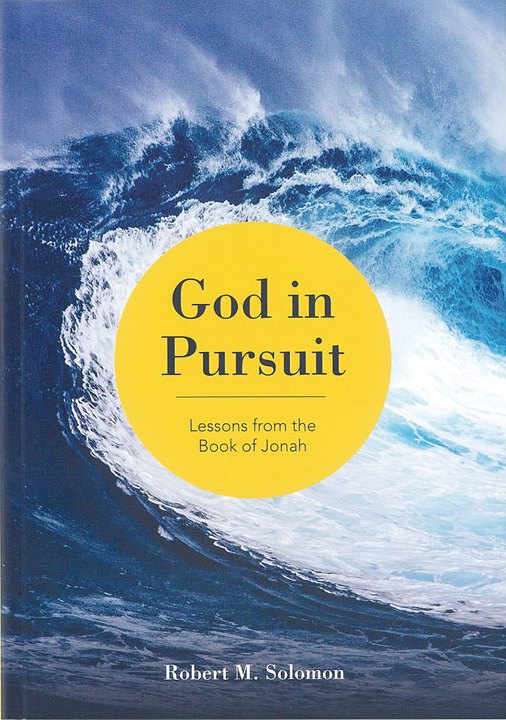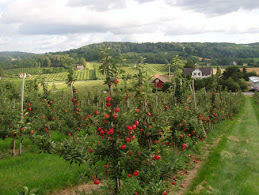By David Roper, Pastor, and regular and popular writer for Our Daily Bread.
A leper came to Jesus one day, probably to everyone's great surprise, for lepers were banned from polite society. (Luke 5:12-14) Dr. Luke describes the man as "covered with leprosy," so he must have been afflicted with an advanced case of the disease. He was all lesions and stumps (wounded, walking stiffly and noisily), discolored and disfigured, shocking in his ugliness, a gross caricature (distortion) of what a human being is intended to be.
Leprosy was a death sentence back then. There was no earthly cure. Lepers were required to wear sackcloth and ashes, emblems (symbol) of mourning. They were "cut off from the land of the living."
Of all diseases, leprosy is the only one singled out by the Law and Prophets and associated with sin. Not because leprosy was sinful, or that sin necessarily led to leprosy, but because the disease was considered a symbol of sin - sin come to the surface. If one could see sin, it was thought, it would look something like an advanced case of leprosy. (Numbers 12; 2 Chronicles 26:16-23; 2 Kings 5:20-27) Furthermore, the end of leprosy is like the end of sin: death. Lepers were the walking death: "a sepulcher (tomb), a moving grave," wrote John Milton.
This man lingered on the outskirts of the crowd, waiting for an opportunity to approach Jesus - but not too close, lest he offend. And then he made his request: "If you are willing," he said to Jesus, "you can make me clean." This plain request for healing is touching and profound in its simplicity.
Sick and troubled people normally elicited (obtained) sympathy from others, but not lepers. They were considered repulsive in every way. They were, in John Milton's words, "disease-ridden men with moldy breath; unwashed men with the ways of death." Nevertheless, Jesus was "moved with compassion." He reached out to this desperate man and hugged him. "Hugged" is exactly the right word. "Touched," the word used by most translators, is much too tame. (John 20:17)
Did our Lord need to hug this leper? Of course He did! It meant everything in the world to the man. It was what "daughter" was to the woman with the defiling hemorrhage; what "neither do I condemn you" was to the woman caught in adultery. No one else could or would have hugged this shocking ugly, diseased man. Only Jesus. (Leviticus 5:3; Isaiah 53:4)
Then Jesus spoke the words. "Be clean" and "immediately the leprosy left him." And with that simple, healing pronouncement the leper was clothed in healthy flesh.
Jesus then sent the man off to the temple to show himself to the priest and to "offer the sacrifices that Moses commanded for your cleansing," and here's where the story gets even better. If the man obeyed, the priest would have located the proper procedure and would have read these instructions, written there in the Law for more than a thousand years. (Leviticus 14:1-9)
The priest was to go outside the camp to the leper, examine him, and declare him clean. Then he was to take two live birds in hand: one to be sacrificed, its blood poured out into an earthen bowl, the other to be bound into a bundle with a piece of cedar and a sprig of hyssop (an aromatic, sponge-like plant), wrapped together with scarlet string. After the first bird was sacrificed, he was then to dip the living bird in the blood in the vessel until the hyssop was saturated with blood, sprinkled the blood seven times on the one cleansed from leprosy, untie the bird, and set it free.
The first bird represents our Savior, washed and pure, then slain in the earthen vessel of His humanity, His blood poured out to take away our sin and sprinkled on the sinner to denote eternal forgiveness. Or as David put it in his memorable phrase, surely thinking of this ancient procedure, "Cleanse me with hyssop, and I will be clean." (Psalm 51:7) Thus we may "draw near to God with a sincere heart in full assurance of faith, having our hearts sprinkled to cleanse us from a guilty conscience and having our bodies washed with pure water."(Hebrews 10:22)
The second bird represents you and me - immobilized and frustrated by our guilt, our hearts beating for freedom like the wings of that frantic little bird, straining against the fetters of guilt and shame that bind us. The little bird was powerless to free itself until it was dipped in the blood of the substitute and set free - free from sin's power to oppress and subdue, free to fly home to God.
You may remember Richard Bach's Jonathan Livingston Seagull, that strange little book about the earnest seagull that grunted (make a low inarticulate sound, typically to express effort or indicate assent) his way up to God. Bach's bird sounded good on paper - people bought the book in more ways than one - but the essential premise was wrong. We cannot take flight from our own soul-sickness. There are too many strings attached.
It is God's birds that show us how to be free. It's the only way to fly.
Behold, I fall before thy face;
My only refuge is thy grace:
No outward forms can make me clean
The leprosy lies deep within.
No bleeding bird, nor bleeding beast,
Nor hyssop branch, nor sprinkling priest,
Nor running brook, nor flood, nor sea,
Can wash the dismal stain away.
Jesus my God, thy blood alone
Hath power sufficient to atone;
Thy blood can make me white as snow
No Jewish types could cleanse me so.
While guilt disturbs and breaks my peace,
Nor flesh nor soul hath rest or ease;
Lord, let me hear thy pard'ning voice,
And make my broken bones rejoice.
- Isaac Watts
https://blogger.googleusercontent.com/img/a/AVvXsEiJK6ZQizGMczDDZxgPwgNnXcSGy7XdgDnh4pTQRzV_VGES_ACObnM13L9_W8vv9PotiQL1hVY_SDuNRoa_ARy1y8VQWRIqkVxALvCZbbMx8sC0kpaL73Vg2RthjSncJaCOSt5xpUe0or8GBVt49E19Q1rtr34BaoxWkntOsIpSlTYrDLMZ1qxFhbY_=s899
https://krasivosti.pro/uploads/posts/2021-07/1626965378_13-krasivosti-pro-p-prikoli-s-popugayami-ptitsi-krasivo-foto-13.jpg
https://krasivosti.pro/pticy/43818-prikoly-s-popugajami.html
Ere (before) long possess the heavens, their all in all.
Picture posted by Anahid. Baxshizade@Anahidbaxshi on 11 October 2018 at 01:22 am
https://blogger.googleusercontent.com/img/a/AVvXsEgsNsLH2AaA7WqJUBVKsGZp-ewAPCW7Fx7R9-8BLrbYJRCDceXd9g93qT2B8HHCKIylqDUx5YVgOo82pTcj7mDCYF9_e_O2vC4kzHuHrAdUYqITlJKqDziUxHhSu3sj2cHB7uefjaLRRkxF92hWz3nJxtzwvy0K_b9T84thnX8mQkmvPX6TtzBjrG7V=s960
https://pbs.twimg.com/media/DpKctLIWsAMogCO.jpg
https://twitter.com/anahidbaxshi/status/1050073991212339201
A leper came to Jesus one day, probably to everyone's great surprise, for lepers were banned from polite society. (Luke 5:12-14) [315] Dr. Luke describes the man as "covered with leprosy," so he must have been afflicted with an advanced case of the disease. He was all lesions and stumps (wounded, walking stiffly and noisily), discolored and disfigured, shocking in his ugliness, a gross caricature (distortion) of what a human being is intended to be.
Leprosy was a death sentence back then. There was no earthly cure. Lepers were required to wear sackcloth and ashes, emblems (symbol) of mourning. They were "cut off from the land of the living."

Picture posted by Levantaos y brillad on Saturday, 21 November 2020 at 07:14 am
https://blogger.googleusercontent.com/img/a/AVvXsEgrO1P4OMEd3H4OfksTybBP_aTtdwiQdFHJjpPXrHhEJp8kABKNCq3O1E6mzBfE_bW-DEINDErie3HLf6Qwi8NSOoTnFe14ON6DynBBgDyUqlYIRpVp4hXWMmd3nQ5X6a4xawcDOIktrYaTPE81cnSE2mtHmc7Y5g8kDA2_43endVOCDHhgUrYR-uZs=s1670
https://scontent.fsin9-1.fna.fbcdn.net/v/t1.6435-9/126800037_699039581009949_383283754657227624_n.jpg?_nc_cat=107&ccb=1-5&_nc_sid=a26aad&_nc_ohc=lDpmJz3ii3wAX_tqHrh&_nc_ht=scontent.fsin9-1.fna&oh=00_AT80d5YfCXRjgcbafCFXoYdSrcCJwQ1duEr5Rn_WsK8TfQ&oe=623DA59F
https://www.facebook.com/photo?fbid=699039564343284&set=pcb.699039631009944
Of all diseases, leprosy is the only one singled out by the Law and Prophets and associated with sin. Not because leprosy was sinful, or that sin necessarily led to leprosy, but because the disease was considered a symbol of sin - sin come to the surface. If one could see sin, it was thought, it would look something like an advanced case of leprosy. (Numbers 12; 2 Chronicles 26:16-23; 2 Kings 5:20-27) [316] Furthermore, the end of leprosy is like the end of sin: death. Lepers were the walking death: "a sepulcher (tomb), a moving grave," wrote John Milton.
This man lingered on the outskirts of the crowd, waiting for an opportunity to approach Jesus - but not too close, lest he offend. And then he made his request: "If you are willing," he said to Jesus, "you can make me clean." This plain request for healing is touching and profound in its simplicity.

Picture posted by Dakota, Diocesan on 26 October 2020 - The Compassion of Christ
https://blogger.googleusercontent.com/img/a/AVvXsEgDkPyNYakv418B9JPKuNkKnSXVGFlLmqCXrZUf6-gE3QrVwXU19faO1o03HkkQFY5ZnIMP7KqO2c-rsRdQqJP15rlqchLffNmLOcz7MWq8u2uNuaQhNCqCfp0hpOWF-poeqxT3O637BnteRbIp-VDwjQtghxavf70gxa2WKq02eVRMrJGzHTE-1gSO=s2560
https://diocesan.com/shop/wp-content/uploads/2020/10/10-26-20-1-scaled.jpg
https://diocesan.com/the-compassion-of-christ/
Sick and troubled people normally elicited (obtained) sympathy from others, but not lepers. They were considered repulsive in every way. They were, in John Milton's words, "disease-ridden men with moldy breath; unwashed men with the ways of death." Nevertheless, Jesus was "moved with compassion." He reached out to this desperate man and hugged him. "Hugged" is exactly the right word. "Touched," the word used by most translators, is much too tame. (John 20:17) [317]

Gospel Illustrations by Tissot, James Jacques Joseph (1836-1902)
Picture posted by Felix Just, S.J., Ph.D.
https://blogger.googleusercontent.com/img/a/AVvXsEhzo_9m1pCBEvs6eggVJvzT9EcT3Yac2GDs9ONCdD98t101YuLTOqkXRpY6KJFkJTYByeDKK6Toiv1RmKa5xHML-bkfBV7OXiErodzuy5K6ubnfMSO0q8ncW5_s9-mgdF_juYmQqA9l7icVq3hG4KwrJKVixWbWK_mjIPOsx9FPWYDvnObJtePl6_Md=s2918
https://catholic-resources.org/Tissot-FullColor/Tissot-1110.jpg
https://catholic-resources.org/Art/Tissot.htm

Picture posted by Dignity - OBITUARY, In Memory Of Shawn Franklin Romero
https://blogger.googleusercontent.com/img/a/AVvXsEhnI9WXHCQODVmYNlwVnZFmCH4KI0xuRxqdauInyB6n8N7mAb2lb-inHebiKTTddSv_oM3TypywMkJsFapUqC0io5n4E3bZ8VA3v37AnX_oqtymYtvHIpws4946kZ3McpSF6aaTusKweiDo_MVJ9ahGV_Wk9K7IA3jiytzGc1BQDKUcpFM8nJzAniWH=s1650
https://d3eguztg5751m.cloudfront.net/as/assets-mem-com/cmi/5/9/5/8/5748595/20131126_100638470_0_orig.jpg/-/shawn-romero-merced-ca-photos1.jpg
https://www.dignitymemorial.com/en-ca/obituaries/merced-ca/shawn-romero-5748595
Did our Lord need to hug this leper? Of course He did! It meant everything in the world to the man. It was what "daughter" was to the woman with the defiling hemorrhage; what "neither do I condemn you" was to the woman caught in adultery. No one else could or would have hugged this shocking ugly, diseased man. Only Jesus. (Leviticus 5:3; Isaiah 53:4) [318]
Then Jesus spoke the words. "Be clean" and "immediately the leprosy left him." And with that simple, healing pronouncement the leper was clothed in healthy flesh.

Picture posted by Δ⚫Danieruˢᶠᶜ⚪✟@TovarishDanieru on 15 January 2022 at 11:43 am
https://pbs.twimg.com/media/FJHSH9WX0AguXaM?format=jpg&name=900x900
https://mobile.twitter.com/TovarishDanieru/status/1482196789570818050?cxt=HHwWhMC-mZGI6ZEpAAAA
Jesus then sent the man off to the temple to show himself to the priest and to "offer the sacrifices that Moses commanded for your cleansing," and here's where the story gets even better. If the man obeyed, the priest would have located the proper procedure and would have read these instructions, written there in the Law for more than a thousand years. (Leviticus 14:1-9) [319]
The priest was to go outside the camp to the leper, examine him, and declare him clean. Then he was to take two live birds in hand: one to be sacrificed, its blood poured out into an earthen bowl, the other to be bound into a bundle with a piece of cedar and a sprig of hyssop (an aromatic, sponge-like plant), wrapped together with scarlet string. After the first bird was sacrificed, he was then to dip the living bird in the blood in the vessel until the hyssop was saturated with blood, sprinkled the blood seven times on the one cleansed from leprosy, untie the bird, and set it free.

The priest was to go outside the camp to the leper, examine him, and declare him clean. Then he was to take two live birds in hand: one to be sacrificed, its blood poured out into an earthen bowl, the other to be bound into a bundle with a piece of cedar and a sprig of hyssop (an aromatic, sponge-like plant), wrapped together with scarlet string. After the first bird was sacrificed, he was then to dip the living bird in the blood in the vessel until the hyssop was saturated with blood, sprinkled the blood seven times on the one cleansed from leprosy, untie the bird, and set it free.
Artwork by Dutch engraver Simon Fokke (1712-1784) - The Metzora being purified with the two birds. B (Rijksmuseum)
Picture posted by Dr. Yitzhaq Feder, The Torah
https://blogger.googleusercontent.com/img/a/AVvXsEgiiqoy3KoZXC7-7LcEgGpzfpjTG0MiJu8mFRyyG1DlORUsgNTGWNxrHg4-I13le_zXLUlFDmkzWFLiMi0ampP_OFjKfZd0_xz_bN6dFqmcG2_ZVSYCFI_FNZjuAT-f5NMhVuVKM2Z77vKydnxvYimcIvEod3PpjWZ5PvdQyEGXLrPxebmMShQhsCmy=s1001
https://assets-global.website-files.com/5b8fd783bee52c8fb59b1fac/60746d7c204a3ec41347c514_Tzaraat%2520Mesopotamian%2520Parallels.jpeg
https://www.thetorah.com/article/tzaraat-in-light-of-its-mesopotamian-parallels
The first bird represents our Savior, washed and pure, then slain in the earthen vessel of His humanity, His blood poured out to take away our sin and sprinkled on the sinner to denote eternal forgiveness. Or as David put it in his memorable phrase, surely thinking of this ancient procedure, "Cleanse me with hyssop, and I will be clean." (Psalm 51:7) [320] Thus we may "draw near to God with a sincere heart in full assurance of faith, having our hearts sprinkled to cleanse us from a guilty conscience and having our bodies washed with pure water."(Hebrews 10:22) [321]

Thus we may "draw near to God with a sincere heart in full assurance of faith, having our hearts sprinkled to cleanse us from a guilty conscience and having our bodies washed with pure water."(Hebrews 10:22)
Picture posted byChristiana Poole
https://blogger.googleusercontent.com/img/a/AVvXsEgddERzerrVCZp65ZLxHRr7U-AiGnizSY_swZNkutLlSrmvj1aNM5nLe5johA9ylALEx0eDFhAR4SbiGkdcN4QvXqx77xi-RlEX2S0Ty97hnojwHztZEnxWZtEy_uoN6gjDq5382jzCLm95mL4_nYzaRzW5atacuqGfCjJpqEfKaVXNHASMK9Q7LP97=s960
https://slideplayer.com/slide/7325775/24/images/35/Leviticus+14%3A5+And+the+priest+shall+command+that+one+of+the+birds+be+killed+in+an+earthen+vessel+over+running+water..jpg
https://slideplayer.com/slide/7325775/
The second bird represents you and me - immobilized and frustrated by our guilt, our hearts beating for freedom like the wings of that frantic little bird, straining against the fetters of guilt and shame that bind us. The little bird was powerless to free itself until it was dipped in the blood of the substitute and set free - free from sin's power to oppress and subdue, free to fly home to God.

Picture posted by Kohkiluyeh and Boyer-Ahmad
https://cdn.borna.news/thumbnail/T1Mu8nDyx0fs/yuiQdPxUgyILPypExSqkWVexFSgSRltN2ZvL5vX-_oL5SMFaqVjbXcnvO0GLTcsXSuxHbdm7768,/156556115.jpg
https://www.borna.news/بخش-گوگل-نیوز-139/942661-فراهم-شدن-زمینه-آزادی-نفر-از-محکومین-به-قصاص
You may remember Richard Bach's Jonathan Livingston Seagull, that strange little book about the earnest seagull that grunted (make a low inarticulate sound, typically to express effort or indicate assent) his way up to God. Bach's bird sounded good on paper - people bought the book in more ways than one - but the essential premise was wrong. We cannot take flight from our own soul-sickness. There are too many strings attached.
It is God's birds that show us how to be free. It's the only way to fly.

It is God's birds that show us how to be free. It's the only way to fly.
Illustration by Danica Novgorodoff
Picture posted by Heather Havrilesky on 03 March 2014 at 11:44 pm
Illustration by by Danica Novgorodoff
https://blogger.googleusercontent.com/img/a/AVvXsEiqC-kdeX9h50kjeupXu-qPLcx_FunzCdHx_cvnFDJWMebmHH4cnnIID5Ya-sahFV74Ha7V9gMl90PzIiF0C2o7Z5UfI089wSnZEqVP-n-ZqqXqJMftp8INWXiVXHWpb5k3KmhkTbVd2Zhq-Y3XDC0BTJuTsSB-uPi7-iIuMF3A_Xum6fejptvPywvg=s590
https://compote.slate.com/images/2fa9d50d-7421-4579-b813-afed55b98b76.jpg?width=840
https://slate.com/culture/2014/03/jonathan-livingston-seagull-new-edition-with-fourth-section-is-dumb-as-ever.html
Behold, I fall before thy face;
My only refuge is thy grace:
No outward forms can make me clean
The leprosy lies deep within.
No bleeding bird, nor bleeding beast,
Nor hyssop branch, nor sprinkling priest,
Nor running brook, nor flood, nor sea,
Can wash the dismal stain away.
Jesus my God, thy blood alone
Hath power sufficient to atone;
Thy blood can make me white as snow
No Jewish types could cleanse me so.
While guilt disturbs and breaks my peace,
Nor flesh nor soul hath rest or ease;
Lord, let me hear thy pard'ning voice,
And make my broken bones rejoice.
- Isaac Watts

the leprosy lies deep within.
No bleeding bird, nor bleeding beast, nor hyssop branch, nor sprinkling priest, nor running brook, nor flood, nor sea, can wash the dismal stain away.
Jesus my God, thy blood alone hath power sufficient to atone; Thy blood can make me white as snow. No Jewish types could cleanse me so. While guilt disturbs and breaks my peace, nor flesh nor soul hath rest or ease; Lord, let me hear thy pard'ning voice, and make my broken bones rejoice. - Isaac Watts
Picture posted by pngwing - Gospel of Luke Cleansing ten lepers
https://blogger.googleusercontent.com/img/a/AVvXsEhEbk0web3a4jFknS2XYIvTIhJ0zYH-16eT3UjfTAOV8hyZZ7QHzb4wJztPRvSA8CT1OBkH6adq06SmF2Aq4uXhNavoTFnscFJp4jZdTArU25JZ1fRzjP42FwhCmp24YT-yKa3dz6pqETebifNjopPPDzVuzMye2k_FmX77y5uV_jTi95g_sFtgXTBh=s931
https://w7.pngwing.com/pngs/766/435/png-transparent-gospel-of-luke-cleansing-ten-lepers-ordinary-time-prayer-october-haloween-prayer-christmas-decoration-2-kings.png
https://www.pngwing.com/en/search?q=cleansing+Ten+Lepers

Of all diseases, leprosy is the only one singled out by the Law and Prophets and associated with sin. Not because leprosy was sinful, or that sin necessarily led to leprosy, but because the disease was considered a symbol of sin - sin come to the surface. If one could see sin, it was thought, it would look something like an advanced case of leprosy. The end of leprosy is like the end of sin: death. Lepers were the walking death: ‘a sepulchre, a moving grave.’
Sick and troubled people normally elicited sympathy from others, but not lepers. They were considered repulsive in every way. They were ‘disease-ridden men with mouldy breath; unwashed men with the ways of death.’
In Luke, leper lingered on the outskirts of the crowd, waiting for an opportunity to approach Jesus - but not too close, lest he offend. And then he made his request: ‘If you are willing,’ he said to Jesus, ‘you can make me clean.’ This plain request for healing is touching and profound in its simplicity. Jesus was ‘moved with compassion.’ He reached out to this desperate man and hugged him. This hug meant everything in the world to the man. No one else could or would have hugged this shocking ugly, diseased man. Only Jesus.
Then Jesus spoke the words. ‘Be clean’ and ‘immediately the leprosy left him.’ And with that simple, healing pronouncement the leper was clothed in healthy flesh.
Jesus then sent the man off to the temple to show himself to the priest and to ‘offer the sacrifices that Moses commanded for your cleansing.’ If the man obeyed, the priest would have located the proper procedure and would have read these instructions, written there in the Law for more than a thousand years.
We learn that the priest was to go outside the camp to the leper, examine him, and declare him clean. Then he was to take two live birds in hand: one to be sacrificed, its blood poured out into an earthen bowl, the other to be bound into a bundle with a piece of cedar and a sprig of hyssop (an aromatic, sponge-like plant), wrapped together with scarlet string. After the first bird was sacrificed, he was then to dip the living bird in the blood in the vessel until the hyssop was saturated with blood, sprinkled the blood seven times on the one cleansed from leprosy, untie the bird, and set it free.
The first bird represents our Saviour, washed and pure, then slain in the earthen vessel of His humanity, His blood poured out to take away our sin and sprinkled on the sinner to denote eternal forgiveness. Thus, we may ‘draw near to God with a sincere heart in full assurance of faith, having our hearts sprinkled to cleanse us from a guilty conscience and having our bodies washed with pure water.’
The second bird represents us - immobilized and frustrated by our guilt, our hearts beating for freedom like the wings of that frantic little bird, straining against the fetters of guilt and shame that bind us. The little bird was powerless to free itself until it was dipped in the blood of the substitute and set free - free from sin's power to oppress and subdue, free to fly home to God.
Lord, we cannot take flight from our own soul-sickness. There are too many strings attached.
It is God's birds that show us how to be free. It's the only way to fly.
Only Jesus our God, with His blood alone has the power sufficient to atone our sins. His blood can make us white as snow. Otherwise, guilt disturbs and breaks our peace. Our flesh and soul have no rest or ease. May we hear Your pardoning voice, and make our broken bones rejoice.
Through Lord Jesus Christ we pray. Amen!"
Picture posted by Redbubble
https://blogger.googleusercontent.com/img/a/AVvXsEjouJkvrB_3T28rLvFEAmWgZUkYcan6M_poP00ipnlJT8vW94rc9BrNBaoNSWLf4XFQQwEjSKTwL6O4SPZH3EyBbXBMc_YAU-ld0mV6rm3aMXZZkzBuyeJpTfWCgyc9nXw8Hp6PCaHlj0bqvwaw2sQEy7F2Ot6IPzEg3JOIjsGprHKA7BKrQukWwOzW=s1000
https://ih1.redbubble.net/image.4109646.3232/flat,1000x1000,075,f.u3.jpg
https://www.redbubble.com/people/digitalmidge/works/1313232-spiritual-freedom
Source (book): "Teach Us to Number Our Days", Chapter 60, "The Little Birds Of God", Page 279.
By David Roper, Pastor, and regular and popular writer for Our Daily Bread.

Reflection - Faithful to the end (Links)
https://veryfatoldman.blogspot.com/2017/06/reflection-faithful-to-end-links.html
"Finding rest for the soul" Responding to Jesus' Invitation in Matthew 11:28-29, © 2016 by Robert M. Solomon

Reflection - Finding rest for the soul (Links)
https://veryfatoldman.blogspot.com/2018/10/reflection-finding-rest-for-soul-links.html
"God in Pursuit" Lessons from the Book of Jonah, © 2016 by Robert M. Solomon

Reflection - God in Pursuit (Links) - PART I-III, posted on Saturday, 10 August 2019
https://veryfatoldman.blogspot.com/2019/08/reflection-god-in-pursuit-links-part-i.html
"God in Pursuit" Lessons from the Book of Jonah, © 2016 by Robert M. Solomon

Reflection - God in Pursuit (Links) - PART IV, posted on Saturday, 10 August 2019
https://veryfatoldman.blogspot.com/2019/08/reflection-god-in-pursuit-links-part-iv.html
"Songs of Christmas", The Stories and Significance of 20 Well-Loved Carols, © 2018 by Robert M. Solomon

Reflection - Songs of Christmas (Links), posted on Friday, 24 April 2020
https://veryfatoldman.blogspot.com/2020/04/reflection-songs-of-christmas-links.html
"Growing Old Gracefully", Following Jesus to the End, © 2019 by Robert M. Solomon

Reflection - Growing Old Gracefully, Part I - III (Links), posted on Wednesday, 09 December 2020
https://veryfatoldman.blogspot.com/2020/12/reflection-growing-old-gracefully-part.html

Reflection - Growing Old Gracefully, Part IV - V (Links), posted on Thursday, 22 April 2021
https://veryfatoldman.blogspot.com/2020/12/reflection-growing-old-gracefully-part_9.html
"Teach Us to Number Our Days", © 2008 by David Roper

Reflection - Number Our Days, Chapter 1 - 40 (Links), posted on Tuesday, 16 November 2021
https://veryfatoldman.blogspot.com/2021/11/reflection-number-our-days-chapter-1-40.html
[315] See Luke 5:12-14.
[316] Miriam (Numbers 12), Uzziah (2 Chronicles 26:16-23), and Gehazi (2 Kings 5:20-27) were punished by Leprosy to symbolize the horrific consequences of their vice, or so I believe. Miriam's complaints, Uzziah's pride, Gehazi's materialism seemed small matters, but were in fact as ugly and as loathsome as leprosy.
[317] The Greek verb haptomai means "to grasp, to take hold of." ("Do not hold on to me," John 20:17.) One ancient version says Jesus reached out his "hands" perhaps enshrining (expressing) a memory of this event.
[318] By touching the unclean leper, Jesus incurred the man's "uncleanness," taking it upon himself (Leviticus 5:3). Jerome translates Isaiah 53:4: "We considered Him a Leper, as it were."
[319] See Leviticus 14:1-9.
[320] Psalm 51:7
[321] Hebrews 10:22
New International Version (NIV), Holy Bible, New International Version®, NIV® Copyright ©1973, 1978, 1984, 2011 by Biblica, Inc.® Used by permission. All rights reserved worldwide.
John 20:17 - https://www.biblegateway.com/passage/?search=John+20%3A17&version=NIV
Leviticus 5:3; Isaiah 53:4 - https://www.biblegateway.com/passage/?search=Leviticus+5%3A3%3B+Isaiah+53%3A4&version=NIV
Leviticus 14:1-9 - https://www.biblegateway.com/passage/?search=Leviticus+14%3A1-9&version=NIV
Luke 5:12-14 - https://www.biblegateway.com/passage/?search=Luke+5%3A12-14&version=NIV
Matthew 11:28-29 - https://www.biblegateway.com/passage/?search=Matthew+11%3A28-29&version=NIV
Numbers 12; 2 Chronicles 26:16-23; 2 Kings 5:20-27 - https://www.biblegateway.com/passage/?search=Numbers+12%3B+2+Chronicles+26%3A16-23%3B+2+Kings+5%3A20-27&version=NIV
Psalm 51:7 - https://www.biblegateway.com/passage/?search=Psalm+51%3A7&version=NIV
- https://blogger.googleusercontent.com/img/a/AVvXsEiJK6ZQizGMczDDZxgPwgNnXcSGy7XdgDnh4pTQRzV_VGES_ACObnM13L9_W8vv9PotiQL1hVY_SDuNRoa_ARy1y8VQWRIqkVxALvCZbbMx8sC0kpaL73Vg2RthjSncJaCOSt5xpUe0or8GBVt49E19Q1rtr34BaoxWkntOsIpSlTYrDLMZ1qxFhbY_=s899
- https://krasivosti.pro/uploads/posts/2021-07/1626965378_13-krasivosti-pro-p-prikoli-s-popugayami-ptitsi-krasivo-foto-13.jpg
- https://krasivosti.pro/pticy/43818-prikoly-s-popugajami.html
- https://blogger.googleusercontent.com/img/a/AVvXsEgsNsLH2AaA7WqJUBVKsGZp-ewAPCW7Fx7R9-8BLrbYJRCDceXd9g93qT2B8HHCKIylqDUx5YVgOo82pTcj7mDCYF9_e_O2vC4kzHuHrAdUYqITlJKqDziUxHhSu3sj2cHB7uefjaLRRkxF92hWz3nJxtzwvy0K_b9T84thnX8mQkmvPX6TtzBjrG7V=s960
- https://pbs.twimg.com/media/DpKctLIWsAMogCO.jpg
- https://twitter.com/anahidbaxshi/status/1050073991212339201
- https://blogger.googleusercontent.com/img/a/AVvXsEgrO1P4OMEd3H4OfksTybBP_aTtdwiQdFHJjpPXrHhEJp8kABKNCq3O1E6mzBfE_bW-DEINDErie3HLf6Qwi8NSOoTnFe14ON6DynBBgDyUqlYIRpVp4hXWMmd3nQ5X6a4xawcDOIktrYaTPE81cnSE2mtHmc7Y5g8kDA2_43endVOCDHhgUrYR-uZs=s1670
- https://scontent.fsin9-1.fna.fbcdn.net/v/t1.6435-9/126800037_699039581009949_383283754657227624_n.jpg?_nc_cat=107&ccb=1-5&_nc_sid=a26aad&_nc_ohc=lDpmJz3ii3wAX_tqHrh&_nc_ht=scontent.fsin9-1.fna&oh=00_AT80d5YfCXRjgcbafCFXoYdSrcCJwQ1duEr5Rn_WsK8TfQ&oe=623DA59F
- https://www.facebook.com/photo?fbid=699039564343284&set=pcb.699039631009944
- https://blogger.googleusercontent.com/img/a/AVvXsEgDkPyNYakv418B9JPKuNkKnSXVGFlLmqCXrZUf6-gE3QrVwXU19faO1o03HkkQFY5ZnIMP7KqO2c-rsRdQqJP15rlqchLffNmLOcz7MWq8u2uNuaQhNCqCfp0hpOWF-poeqxT3O637BnteRbIp-VDwjQtghxavf70gxa2WKq02eVRMrJGzHTE-1gSO=s2560
- https://diocesan.com/shop/wp-content/uploads/2020/10/10-26-20-1-scaled.jpg
- https://diocesan.com/the-compassion-of-christ/
- https://blogger.googleusercontent.com/img/a/AVvXsEhzo_9m1pCBEvs6eggVJvzT9EcT3Yac2GDs9ONCdD98t101YuLTOqkXRpY6KJFkJTYByeDKK6Toiv1RmKa5xHML-bkfBV7OXiErodzuy5K6ubnfMSO0q8ncW5_s9-mgdF_juYmQqA9l7icVq3hG4KwrJKVixWbWK_mjIPOsx9FPWYDvnObJtePl6_Md=s2918
- https://catholic-resources.org/Tissot-FullColor/Tissot-1110.jpg
- https://catholic-resources.org/Art/Tissot.htm
- https://blogger.googleusercontent.com/img/a/AVvXsEhnI9WXHCQODVmYNlwVnZFmCH4KI0xuRxqdauInyB6n8N7mAb2lb-inHebiKTTddSv_oM3TypywMkJsFapUqC0io5n4E3bZ8VA3v37AnX_oqtymYtvHIpws4946kZ3McpSF6aaTusKweiDo_MVJ9ahGV_Wk9K7IA3jiytzGc1BQDKUcpFM8nJzAniWH=s1650
- https://d3eguztg5751m.cloudfront.net/as/assets-mem-com/cmi/5/9/5/8/5748595/20131126_100638470_0_orig.jpg/-/shawn-romero-merced-ca-photos1.jpg
- https://www.dignitymemorial.com/en-ca/obituaries/merced-ca/shawn-romero-5748595
- https://depositphotos.com/upscaler.html?utm_source=newsletter&utm_medium=email&utm_term=button2&utm_campaign=ntf_upscaler&utm_content=en&iterable_campaign=2704095&iterable_template=3704971
- https://blogger.googleusercontent.com/img/a/AVvXsEj4ITRTEC7Fn8b2omArK85272V9g2_67kU4mfsJmdjbP3Cw2lpIljpnLRl2iy6c7txX5PmRv571pRRybZJ4MwjANw-FVtQn6zihsXc3m4aAK-N_OAzc21CoP3J22iWLGV0-VouN5rcaavfkiwNnjpXxpM5TaRnV5SefvqLU0936UqQpkVQ5JrZS-Vp7=s1438
- https://pbs.twimg.com/media/FJHSH9WX0AguXaM?format=jpg&name=900x900
- https://mobile.twitter.com/TovarishDanieru/status/1482196789570818050?cxt=HHwWhMC-mZGI6ZEpAAAA
- https://blogger.googleusercontent.com/img/a/AVvXsEgiiqoy3KoZXC7-7LcEgGpzfpjTG0MiJu8mFRyyG1DlORUsgNTGWNxrHg4-I13le_zXLUlFDmkzWFLiMi0ampP_OFjKfZd0_xz_bN6dFqmcG2_ZVSYCFI_FNZjuAT-f5NMhVuVKM2Z77vKydnxvYimcIvEod3PpjWZ5PvdQyEGXLrPxebmMShQhsCmy=s1001
- https://assets-global.website-files.com/5b8fd783bee52c8fb59b1fac/60746d7c204a3ec41347c514_Tzaraat%2520Mesopotamian%2520Parallels.jpeg
- https://www.thetorah.com/article/tzaraat-in-light-of-its-mesopotamian-parallels
- https://blogger.googleusercontent.com/img/a/AVvXsEgddERzerrVCZp65ZLxHRr7U-AiGnizSY_swZNkutLlSrmvj1aNM5nLe5johA9ylALEx0eDFhAR4SbiGkdcN4QvXqx77xi-RlEX2S0Ty97hnojwHztZEnxWZtEy_uoN6gjDq5382jzCLm95mL4_nYzaRzW5atacuqGfCjJpqEfKaVXNHASMK9Q7LP97=s960
- https://slideplayer.com/slide/7325775/24/images/35/Leviticus+14%3A5+And+the+priest+shall+command+that+one+of+the+birds+be+killed+in+an+earthen+vessel+over+running+water..jpg
- https://slideplayer.com/slide/7325775/
- https://blogger.googleusercontent.com/img/a/AVvXsEjI_jekv_lydi7jKkHnuOval0_mva3DFH0L_ZbqXond7rGOuMKYSNQ7cE9xtwFS8RgFu3x_qZaHQsEUtA0P2Mc9Ip5oWqQGhl2y5azHQqy4Lzl4Z_3x6o_Jjfdc04seSrWCDoR3HmHhUTr0GSbb7KURatl10dtUg4OeMAN6kRDGnohhaJBFDl3aRQWb=s1200
- https://cdn.borna.news/thumbnail/T1Mu8nDyx0fs/yuiQdPxUgyILPypExSqkWVexFSgSRltN2ZvL5vX-_oL5SMFaqVjbXcnvO0GLTcsXSuxHbdm7768,/156556115.jpg
- https://www.borna.news/بخش-گوگل-نیوز-139/942661-فراهم-شدن-زمینه-آزادی-نفر-از-محکومین-به-قصاص
- https://blogger.googleusercontent.com/img/a/AVvXsEiqC-kdeX9h50kjeupXu-qPLcx_FunzCdHx_cvnFDJWMebmHH4cnnIID5Ya-sahFV74Ha7V9gMl90PzIiF0C2o7Z5UfI089wSnZEqVP-n-ZqqXqJMftp8INWXiVXHWpb5k3KmhkTbVd2Zhq-Y3XDC0BTJuTsSB-uPi7-iIuMF3A_Xum6fejptvPywvg=s590
- https://compote.slate.com/images/2fa9d50d-7421-4579-b813-afed55b98b76.jpg?width=840
- https://slate.com/culture/2014/03/jonathan-livingston-seagull-new-edition-with-fourth-section-is-dumb-as-ever.html
- https://blogger.googleusercontent.com/img/a/AVvXsEhEbk0web3a4jFknS2XYIvTIhJ0zYH-16eT3UjfTAOV8hyZZ7QHzb4wJztPRvSA8CT1OBkH6adq06SmF2Aq4uXhNavoTFnscFJp4jZdTArU25JZ1fRzjP42FwhCmp24YT-yKa3dz6pqETebifNjopPPDzVuzMye2k_FmX77y5uV_jTi95g_sFtgXTBh=s931
- https://w7.pngwing.com/pngs/766/435/png-transparent-gospel-of-luke-cleansing-ten-lepers-ordinary-time-prayer-october-haloween-prayer-christmas-decoration-2-kings.png
- https://www.pngwing.com/en/search?q=cleansing+Ten+Lepers
- https://blogger.googleusercontent.com/img/a/AVvXsEjouJkvrB_3T28rLvFEAmWgZUkYcan6M_poP00ipnlJT8vW94rc9BrNBaoNSWLf4XFQQwEjSKTwL6O4SPZH3EyBbXBMc_YAU-ld0mV6rm3aMXZZkzBuyeJpTfWCgyc9nXw8Hp6PCaHlj0bqvwaw2sQEy7F2Ot6IPzEg3JOIjsGprHKA7BKrQukWwOzW=s1000
- https://ih1.redbubble.net/image.4109646.3232/flat,1000x1000,075,f.u3.jpg
- https://www.redbubble.com/people/digitalmidge/works/1313232-spiritual-freedom











































.jpg)
.gif)
.jpg)

















































%20-%20%E5%82%B7%E5%BF%83%E7%9A%84%E8%B7%AF%20(Sh%C4%81ng%20x%C4%ABn%20de%20l%C3%B9)%20-%20The%20Road%20of%20Sorrow%20(With%20Subtitle)_11.png)






